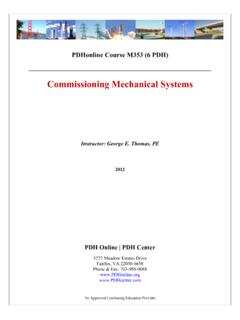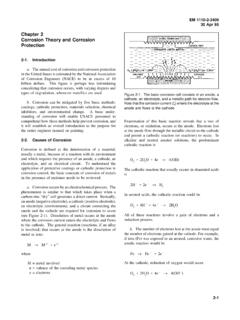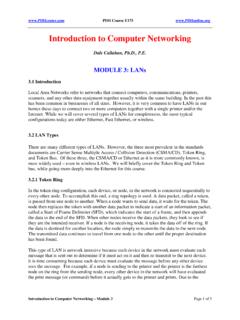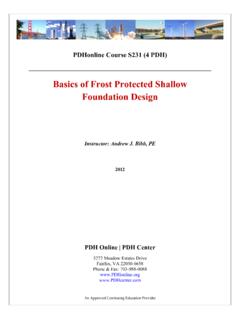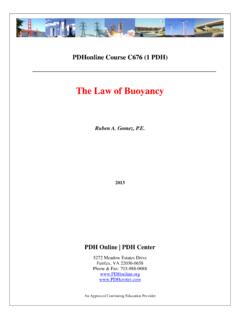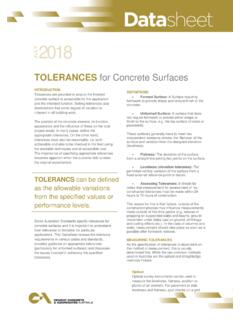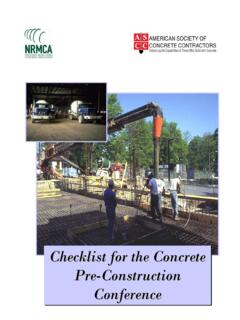Transcription of The Construction and Design of Concrete Slabs on Grade
1 PDHonline Course S226 (8 PDH)The Construction and Design ofConcrete Slabs on Grade2012 Instructor: Matthew Stuart, PE, SEPDH Online | PDH Center5272 Meadow Estates DriveFairfax, VA 22030-6658 Phone & Fax: Approved Continuing Education PDH Course S226 D. Matthew Stuart Page 2 of 36 The Construction and Design of Concrete Slabs on Grade D. Matthew Stuart, , , , SECB COURSE CONTENT Slab on Grades Construction : Introduction Concrete Slabs on Grade are a very common type of Concrete Construction . floor Slabs can range from a simple residential basement slab to a heavy-duty industrial floor . However, no matter how basic or complex the floor is, the Construction method is similar and includes; preparing the sub- Grade and sub-base, placing the reinforcement and Concrete , and finishing and curing the slab.
2 The quality of a completed floor slab is dependent on; an appropriate Design , the quality of the materials used and the knowledge and experience of the workmen who place and finish the Concrete . Other considerations that play a role in the successful Construction of a slab on Grade include; proper proportioning of the Concrete mix, joint Design and performance, and the slab thickness. floor Classifications Table 1 describes the nine classes of Concrete floors according to ACI 302, Guide to Concrete floor and Slab Construction . This table details some of the special considerations and finishing techniques that are appropriate for each class of floor . Within each class, unique factors such as local sub- Grade conditions, locally available materials, and the placement environment should be considered for each individual Design .
3 Large Concrete floors for commercial and industrial buildings must be designed and constructed using the greatest possible economy that results in a serviceable slab for the anticipated service life of the slab. To accomplish this goal, the Construction of floor Slabs requires close communication between the owner, architect, engineer, contractor and material supplier. The expectations and responsibilities of each participant should be established at a pre- Design , pre-bid, and pre- Construction meeting. At the pre- Design meeting, the owner/user should answer the following questions: 1. How will the floor be used? 2. What types and magnitudes of floor loadings are anticipated? 3. What are the aesthetic requirements of the finish, including acceptability of random slab cracking?
4 4. Will floor coverings, coatings, or special toppings be used? The Design and Construction of Concrete floors on ground does not need to be a complicated procedure. However, the process should be based on the unique project specific variables involved. Factors such as soil conditions, anticipated loading, weather conditions during Construction , and the properties of locally available materials all influence the appearance and serviceability of a floor slab. While a specific Design PDH Course S226 D. Matthew Stuart Page 3 of 36 may work well in one situation, the same Design or Construction methods may not achieve the same results on another project.
5 Even when the expected loading or use is identical, other factors are not likely to remain consistent, therefore each project should be evaluated separately. TABLE 1 PDH Course S226 D. Matthew Stuart Page 4 of 36 floor Performance Criteria Many Concrete floors built today can be highly complex with significant demands placed on them. For example, new warehouse facilities are often designed for high-density storage. This means the facility could potentially experience tall rack post and other extremely heavy loads, or require very restrictive floor flatness and levelness criteria to assure the proper operation of the equipment that stores and moves goods.
6 As a result, floors can account for more complaints than any other part of a building, primarily because they are so critical to the proper use and operation of the building and also because any problems that develop are so readily exposed to view. To address this situation, careful attention must be given to the many factors that influence floor performance which include: 1. Uniformity of the sub- Grade and adequacy of its bearing capacity. 2. Moisture content of the sub- Grade and sub-base. 3. Quality of the Concrete (particularly shrinkage potential). 4. Adequacy of the structural capacity. 5. Surface levelness and flatness . 6. Deformations ( settlement) under applied loads. 7. Load transfer at the control and Construction joints.
7 8. Type and spacing of the control and Construction joints. 9. Workmanship and jobsite conditions. 10. Sub-slab details ( vapor retarders - some times referred to as vapor barriers, insulation, etc.,). 11. Concrete moisture conditions and drying rate. 12. Special surface finishes, including coatings. 13. Adequacy of curing. Sub- Grade and Sub-Base The sub- Grade is the ground on which the floor is built. The sub-base is an optional layer located on top of the sub- Grade and beneath the slab bottom (see Figure 1). The sub-base, while not mandatory, can provide added benefits to the Construction and performance of the slab. It is vital to consider sub- Grade preparation during Design and Construction to assure that the Concrete floor will carry the intended loads successfully and without significant settlement.
8 PDH Course S226 D. Matthew Stuart Page 5 of 36 FIGURE 1 Because Concrete floor Slabs are rigid, concentrated loads from forklift wheels or rack posts are spread over a larger area of sub- Grade which results in lower pressures than the slab surface is exposed to. Therefore, Concrete floors do not necessarily require strong support from the sub- Grade . However, strong support from sub-grades or sub-bases improves slab edge support. The sub- Grade can be improved by proper drainage and adequate compaction or soil stabilization. In cases of extremely poor soil, removal and replacement of the sub- Grade with an off site compactable material will often be necessary.
9 To construct a reasonably uniform sub- Grade , special care must be taken to assure that there is minimal variation of support within the floor area (generally provided by proper proof rolling) and that the following major causes of non-uniform support are identified and controlled: 1. Expansive soils. 2. Hard and soft spots. 3. Improper backfilling. 4. Sub- Grade and sub-base strength. Bearing capacity, compressibility, and the modulus of sub- Grade reaction are all measures of strength deformation properties of soil. Therefore it is important to consider how these parameters apply to the Design of floor Slabs . The allowable soil bearing pressure is the maximum pressure that can be permitted on supporting soil with adequate safety against shear failure or excessive settlement.
10 Another soil characteristic, compressibility of cohesive soils, determines the potential amount of long-term settlement under any imposed load. A third measure of soil strength, Westergaard s Modulus of Sub- Grade reaction, k, is the most commonly used soil parameter in the Design of Concrete pavements and Slabs on Grade . The use of the k value is appropriate for the Design of pavements and floor Slabs that do not support columns or loadbearing walls. There is no reliable correlation between the three measures of soil properties; modulus of sub- Grade reaction (k), soil bearing capacity and soil compressibility, because they are all measurements of entirely different characteristics of any given soil. The k value used for floor slab Design reflects the response of the sub- Grade under temporary (elastic) conditions and small deflections, usually inches or less.
